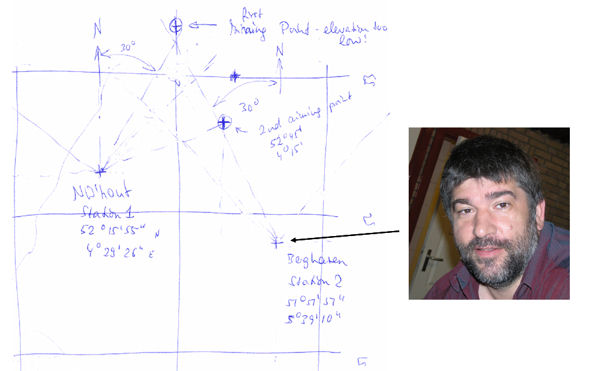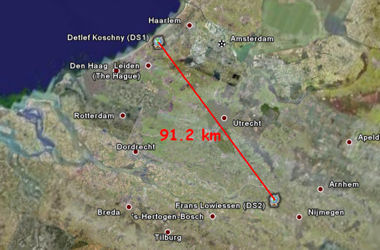|
To prepare for our planned double-station meteor video camera setup in the Canary Islands (CILBO), we have tested such a setup in a collaboration with Frans Lowiessen from the Werkgroep Meteoren in the first half of the year 2007. To avoid problems with the Moon coming into the field of view, we pointed both cameras towards the north. The disadvantage of such a setup is that the so-called convergence angle, i.e. the angle between the line of sights to the meteor from the two stations is small, resulting in larger errors in the position determination. Still, from an operational point of view not having to worry about the Moon damaging the intensifiers was a very positive point.
Figure 1 shows a sketch of the setup, together with a photograph of Frans. Table 1 gives details on the station locations and pointing directions. Figure 2 is a Google Earth view of the two stations, the distance between them was 91 km.
Figure 1: Sketch of the setup in The Netherlands, and a photo of Frans Lowiessen.
Table 1: Station locations and pointing directions.
| Station name |
Camera
code |
Latitude |
Longitude |
Pointing
azimuth |
Pointing
elevation |
| Noordwijkerhout |
ICC4 |
52 15'55" |
04 29'26" |
217.6 |
60.6 |
| Bergharen |
ICC2 |
51 51'51" |
05 39'10" |
153.7 |
45.1 |
| Aiming point |
|
52 40'00" |
05 00'00" |
100 km |
height |
|
|
 Figure 2: Google Earth view of the two stations. Figure 2: Google Earth view of the two stations.
Results
Performing double-station observations from a location as the Netherlands is not easy. In the period Feb to Apr 2007 (89 nights), at least one of the cameras was active for a total of 34 nights, i.e., 38 % of all nights. However, in only 13 of these nights (38 %) were double-station meteors observed, i.e., 15 % of all nights.
ICC4, located at Noordwijkerhout, always had the worse conditions as the sky is much brighter at that location than at Bergharen. Still, not all meteors registered by ICC4 were simultaneously observed by ICC2 and vice versa. Typically, 30 to 60 % of the number of meteors recorded by ICC4 were registered simultaneously by ICC2. In this observing run of 3 months, a total of 72 meteors were observed by both cameras. While this is a small number compared to the setup on the Canary Islands (see next section), it still shows that it is possible and useful to operate a regular double-station setup under these conditions.
Page prepared by dvk, 06 Dec 2008. Fixed missing images 03 Oct 2016.
|